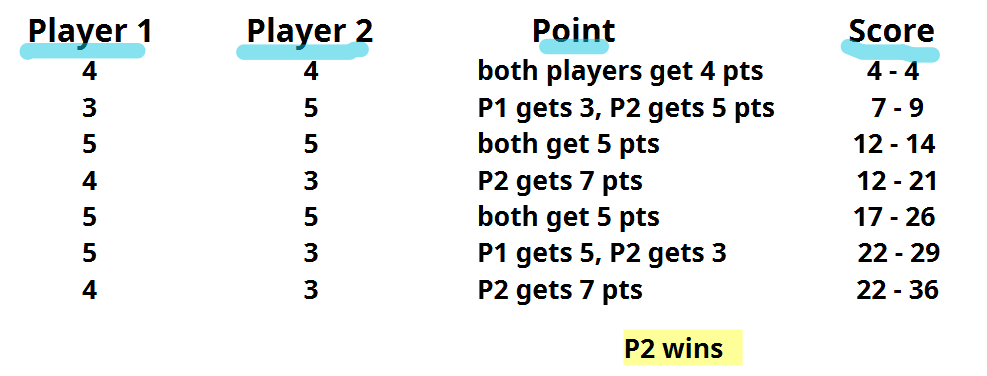Games We Play #3: Undercut
A quick-chance game.
I came across this game on Jennifer Firkins Nordstrom’s Introduction to Game Theory which is an open textbook on game theory.
Each player chooses a number 1-5. If the two numbers don't differ by 1, then each player adds their own number to their score. If the two numbers differ by 1, then the player with the lower number adds both numbers to his or her score; the player with the higher number gets nothing. (From Douglas Hofstadter's Metamagical Themas.)
You will need a sheet perhaps to keep the score.
The game ends when one of the players reach a difference of 11.
When we played the game in the class, some students immediately developed a strategy of showing 4 or 5. Since the initial urge is to show 5, going with 4 and undercutting the opponent is likely. One pair played as the following:
This was a short game. P1 feels that P2 will go with 5, shows 4 and undercuts to get all 9 points. The second player influenced from the first round tris 3 to undercut P1, but this time P1 plays 5 and wins the game. Clever.
The same pair’s game was longer in the next trial . They tested each other and tried to be safe for a while. At the end, playing 3 helped P2 to undercut P1 twice to win the game.
It seems there is no best strategy to win this game. Knowing your opponent can be helpful though. In the practice I had to change pairs few times as some students could easily manipulate or sort out their friends’ moves. So, we can say that, seeking patterns in your opponents’ moves can be helpful. Choosing low numbers might work in the long run, but doing the same as a pattern can help your opponent to guess your next step and win easily. Therefore randomization will be more meaningful.
As I played this game with young students, we were not able to calculate expected values. This requires algebra knowledge (systems of equations). However, students agreed that this is a fair game as each player has an equal opportunity to choose a number, and the outcome of each round is determined by chance. On the other hand the game cannot be played totally randomly. You need to follow your opponent’s moves.
We enjoyed playing Undercut. It is a fun game and could be played nearly in every level. I hope you like it, too.






